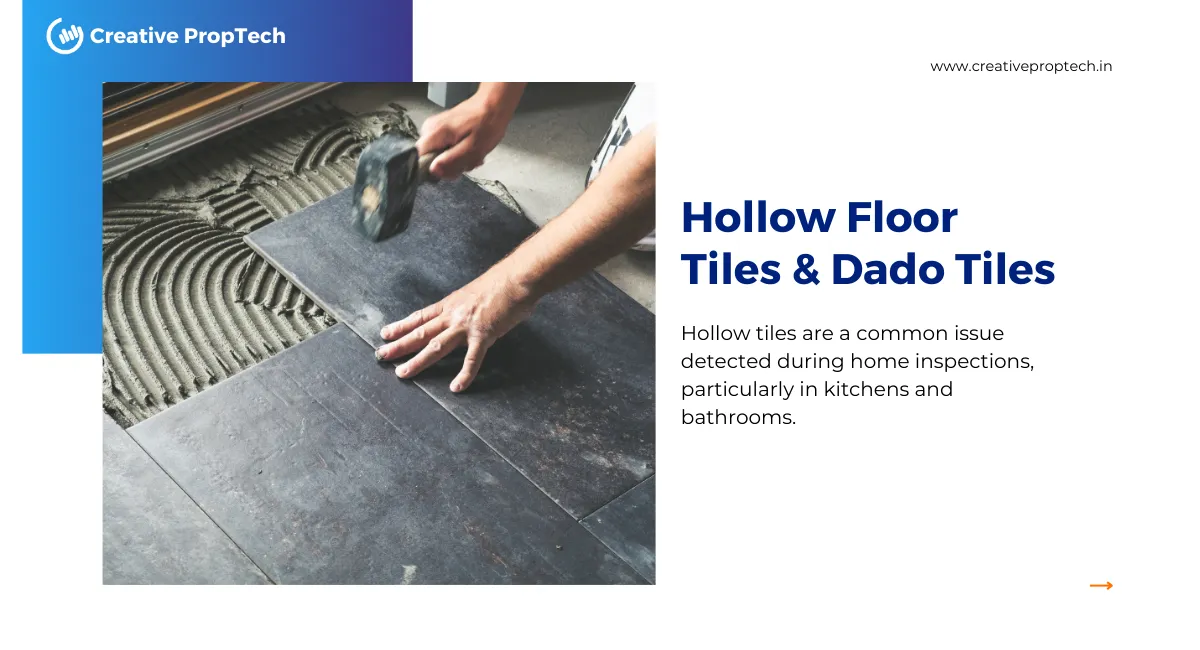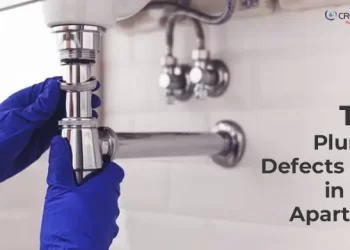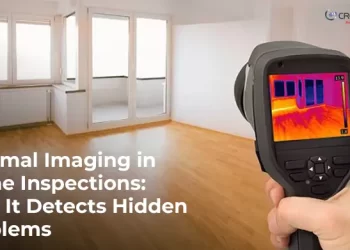A home inspection is a crucial step in the buying process, especially when purchasing new or resale properties.
It provides a comprehensive evaluation of the property’s condition, identifying issues that may not be immediately visible.
Addressing these problems early can save you from unexpected costs and ensure your home is safe and functional.
In this blog, we’ll discuss the Top 10 common problems found during a home inspection, exploring each issue in detail.
1. Hollow Floor Tiles & Dado Tiles
 Hollow tiles are a common issue detected during home inspections, particularly in kitchens and bathrooms.
Hollow tiles are a common issue detected during home inspections, particularly in kitchens and bathrooms.
This problem arises when tiles are not properly bonded to the surface, creating air pockets underneath.
When tapped, these tiles produce a hollow sound, indicating weak adhesion.
Hollow tiles are more prone to cracking and can lift over time, which can create unsightly and potentially unsafe conditions.
A professional tile installer can address this issue by re-laying or re-grouting tiles to ensure they adhere firmly to the surface, preventing future problems.
2. Rising Damp or Transfer Damp
Rising damp occurs when moisture from the ground moves up through walls and floors, causing visible damp patches, peeling paint, and sometimes mold growth.
This issue is common in older buildings or those with poor waterproofing, where damp-proofing measures were not implemented effectively.
Rising damp can compromise structural integrity, lead to mold growth, and create an unhealthy living environment.
A professional inspection can help assess the extent of the dampness and recommend waterproofing solutions, such as damp-proof membranes or anti-damp treatments on walls.
3. Electrical Switches Not Working
 Non-functional electrical switches are frequently found during home inspections.
Non-functional electrical switches are frequently found during home inspections.
This issue often stems from faulty wiring, loose connections, or the use of low-quality switches that do not hold up over time.
Malfunctioning switches may indicate broader electrical issues, posing a safety risk, especially if there are exposed wires.
An electrician can inspect and replace faulty switches, ensuring all electrical connections are safe and in good working order.
4. Standard Voltage Not Available
 Inconsistent or non-standard voltage is another issue found in some properties, which can lead to damage to electrical appliances and affect their performance.
Inconsistent or non-standard voltage is another issue found in some properties, which can lead to damage to electrical appliances and affect their performance.
This problem might result from inadequate wiring, outdated electrical systems, or power supply issues specific to the area.
Voltage instability can cause frequent power fluctuations, impacting appliance longevity and even posing a fire hazard in severe cases.
An electrician can help assess the wiring and electrical panel, and may recommend upgrading components to stabilize voltage levels and protect your appliances.
5. Earthing Not Provided
Proper earthing is a critical safety measure that diverts excess electricity to the ground, preventing electric shocks and damage to appliances.
Some properties, especially older ones, may lack sufficient earthing, which increases the risk of electric shock and appliance damage.
Ensuring proper earthing is essential for electrical safety. An electrician can evaluate the system and install or upgrade earthing connections if necessary to protect your home and its occupants.
6. Water Pressure Not Maintained
Low or inconsistent water pressure is a frequent problem uncovered during home inspections, particularly in bathrooms and kitchens.
This issue may result from clogged pipes, incorrect pipe sizes, or faults in the water supply line, affecting daily tasks and comfort.
A plumber can assess the system for any blockages, leaks, or incorrect installations and may suggest solutions such as installing a pressure pump or adjusting pipes to improve water flow throughout the home.
7. Door Hardware Not Working
Faulty door hardware, including locks, handles, and latches, often occurs due to improper installation, misalignment, or wear and tear over time.
This can affect the security and functionality of doors, making them difficult to operate and compromising safety.
Repairing or replacing door hardware can restore smooth functionality and security. A locksmith or carpenter can assist with adjusting or replacing any misaligned or damaged hardware components.
8. Door Hinges Not Properly Screwed
Improperly screwed hinges are another common issue, particularly in homes where doors were hastily installed.
Loose or misaligned hinges make doors difficult to open or close and can lead to sagging doors that scrape the floor or damage the frame.
To resolve this, hinges may need tightening or replacing, and a carpenter can help reposition them if necessary to maintain proper alignment.
09. Toilet Hardware Not Installed Properly
Improperly installed toilet hardware, including faucets, flush systems, and showerheads, is a frequent issue that can lead to leaks, low water flow, or hardware failure.
Such problems affect bathroom functionality and water efficiency, leading to unnecessary waste and discomfort.
A plumber can re-install faulty hardware or replace it with correctly functioning components, improving water flow and conserving water in the long term.
10. Grouting in Tiles Missing
Missing grout between tiles is a common finding in kitchens and bathrooms, where tiles are exposed to moisture.
Grout serves as a protective barrier against water seepage, and its absence can lead to water damage and even mold growth.
Re-grouting is a simple fix that can prevent moisture buildup and maintain the durability and appearance of tiled areas.
Conclusion
Understanding these common problems found during home inspections can help you identify potential red flags and take proactive measures.
A thorough home inspection can save you from unexpected costs by uncovering these issues.
Schedule your home inspection and find this issues before you invest in a property.
Addressing these issues early on not only protects your investment but also ensures a safe, comfortable, and welcoming home for you and your family.














